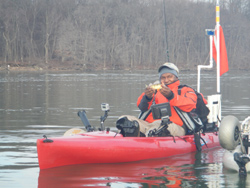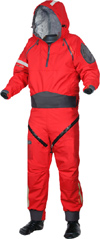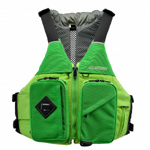What To Wear for Kayak Fishing
Much of the decision of what to wear depends on personal preference. There is no single outfit that is perfect for all weather conditions. The key consideration is to make sure you are protecting yourself from the elements - sun, spray, waves, possible capsizing and are comfortable enough for the duration of your fishing trip.
You do want to be comfortable and as dry as possible for an extended length of time. It is important to dress appropriately for the conditions. Plan for the worst-case scenario, and pay attention to water temperature! Always keep a change of clothes in your car so you can change if you get too wet.
Warm Weather – Summer
Let’s start with the warm weather time of the year. The sun’s rays can be harmful to eyes (cataracts) and skin (wrinkling and skin cancer). Many kayakers wear bathing suits, shorts, and short sleeve shirts to avoid the heat during warm weather months. This feels great but can lead to excessive sun exposure. Others wear long sleeve shirts and long pants (often quick-dry fishing shirts and pants) to reduce exposure. In this website we are not promoting any particular set of clothing, but do want to make sure that those starting out are aware of some of the consequences of too much sun.

In addition to shirts and pants, kayakers may want to protect other body parts from the sun. Most kayakers wear some type of hat and sunglasses. Some go the extra step of wearing a buff to cover most of the face from sun or sun gloves to protect their hands. Sunscreen and lip balm can provide temporary protection of exposed skin. If you use these products, don’t forget to reapply periodically.
During warm weather, kayakers can use a variety of footwear or may choose to go barefoot. There are numerous styles of shoes designed for use in the water (e.g., sandals, Crocs, water shoes) or old sneakers can serve the same function.
Cooler Weather - Spring and Fall

As air and water temperatures cool off, most kayakers are happy to add more layers of protection. At some threshold temperature, kayakers will choose to switch from sneakers or water shoes to warmer waterproof footwear (often neoprene or rubber boots, or waterproof socks). Having cool water dripping on your legs does not feel as good as it does in the summer.

Kayakers may switch to lightweight dry suits or flexible waders to keep their feet, legs and butts dry. Others may switch to waterproof rain pants. Since launching your kayak often involves wading in the potentially-cold water, waders are often a favored choice.
Kayakers also look to warmer shirts and waterproof jackets to protect from spray, splash and rain. Wearing multiple layers offers a more flexible solution, as layers can be removed if the temperature rises. A lightweight waterproof shell over a sweatshirt is a popular option. A wicking base layer is recommended to prevent excessive sweating.
Cold Weather – Winter
As the air and water temperature continues to drop, protection against the elements becomes more than just a matter of comfort – capsizing in cold water can quickly lead to hypothermia and possible death. It is critical to dress with sufficient protective garments to make sure you have reasonable odds of surviving a spill into cold water.
Here are two general rules regarding dressing for cold weather.
- When the air temperature + the water temperature exceeds 120°F, there is a risk of hypothermia. The risk increases as the sum of temperatures drops.
- In general, avoid cotton garments. Stick to fleece, wool, and polyester-based materials.


The most protective garment for cold water is a full dry suit. This provides a continuous layer of waterproof fabric to cover you from neck to wrists to feet. Dry suits typically have snug latex or rubber gaskets around any openings. Dry suits tend to be expensive and may be uncomfortable to wear.
Another similar option is to use separate dry pants and a dry top. This combination is easier to put on and take off, and allows easier access for bathroom breaks. Another variation of a two-piece option is chest waders topped by a dry top. The chest wader provides protection from chest to feet. The dry top protects the torso. Some models of dry tops use more comfortable neoprene gaskets at neck, wrists, and waist.

When choosing your winter garments, think about where you are likely to be kayaking or fishing during cold weather times. If you plan to fish in sheltered areas near shallow water, you may choose differently that you would if you plan to fish in fast-moving rivers or in deep open water far from shore.
Regardless of what you wear on your body, remember to wear a warm hat and gloves. Sunglasses and sunscreen are important in cold weather months too - even though it doesn't feel like it, you can get a sunburn even on the coldest sunny days.

Although capsizing is not common, it can happen unexpectedly. It is wise to bring a change of warm clothes and keep them in a dry bag in the winter time in case you should capsize and need to warm up quickly. Doing things like jumping jacks/squat thrusts or building a fire may be necessary if you can’t get to your vehicle.
No matter what season is, you should always have a personal flotation device (PFD) with you. The PFD does not protect you unless you are wearing it. We encourage kayakers to wear their PFDs at all times when in their kayaks. More on PFDs is covered in the section on Basic Gear.
 Follow us
Follow us









